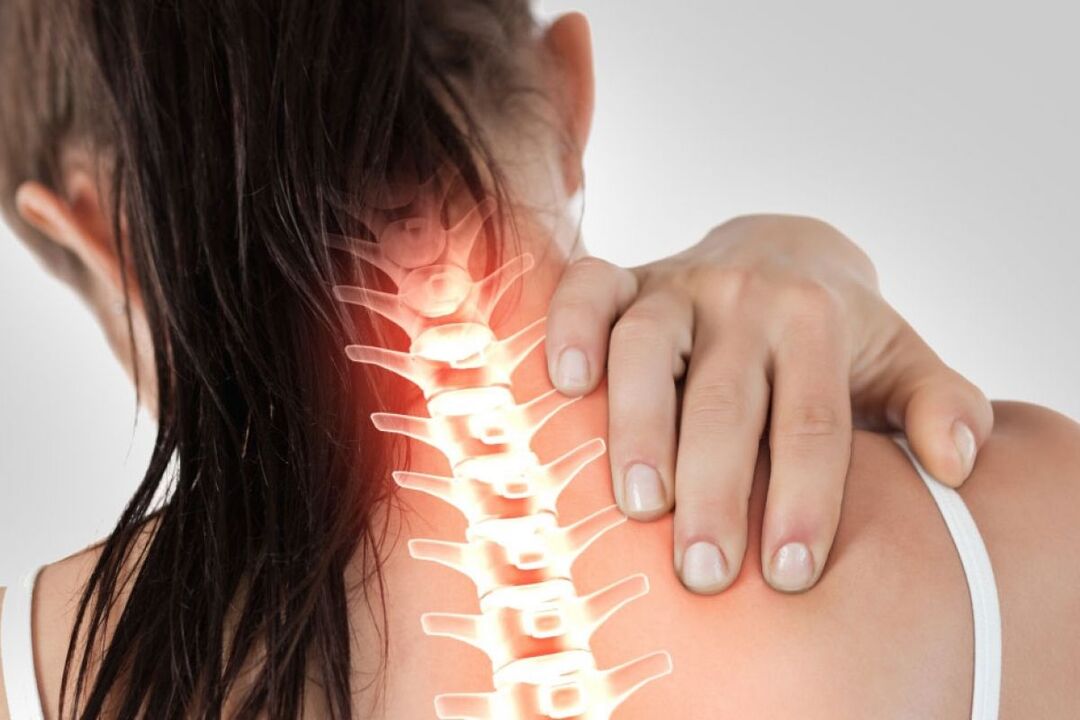Osteochondrosis is a process of degeneration, aging, decomposition of cartilage tissue and its transformation into a kind of bone. To understand the problem of osteochondrosis, you need to imagine the structure of the spine: it consists of 35 vertebrae that are placed one above the other in a column, forming a spine. Between the vertebrae there are "pads" - cartilaginous discs (they act as a shock absorber and lubricant when moving the vertebrae), the discs consist of a hard multilayer ring and a liquid gelatinous core in the center.
To understand the problem of osteochondrosis, you need to imagine the structure of the spine: it consists of 35 vertebrae that are placed one above the other in a column, forming a spine. Between the vertebrae there are "pads" - cartilaginous discs (they act as a shock absorber and lubricant when moving the vertebrae), the discs consist of a hard multilayer ring and a liquid gelatinous core in the center.
Symptoms of cervical osteochondrosis:
Everyone knows that the spine becomes thinner in structure closer to the head. The upper vertebrae, which make up the cervical area, are long, elegant, but very strong and mobile. However, their strength is not unlimited, especially when the daily stress on the neck exceeds the norm. The main causes of osteochondrosis of the cervical spine are always hidden in these loads.
How osteochondrosis of the cervical spine manifests itself also depends on the type of load and the location of the spinal disc damage: each nerve root is responsible for a specific function, which is why the manifestations of cervical osteochondrosis are so diverse. The development of the disease proceeds in 4 stages. Each one is more difficult than the previous one.
Stage 1 cervical osteochondrosis:
How can our spine be protected from overuse and destructive physical activity (or inaction)?
First of all, discomfort: stretching, tingling, shooting - all these are the first signs of any disease of the spine.
Intervertebral osteochondrosis of the cervical spine begins with a feeling of tension in the muscles of the neck, their fatigue. The patient may feel slight pain, crunch when turning and tilting the head. Quite often such discomfort is perceived as "probably cold" or "I'm tired of something".
I remember! Pain is a sign, we can say signaling our body, if it worked, it's not just that. The pain cannot be ignored or numb with pills!
Stage 2:
The patient already feels more intense pain when turning and tilting the head. Sometimes the pain radiates (spreads) to the right or left arm, the shoulder joint, sometimes the arm.
On the part of the nervous system there are still rare headaches, fatigue, tiredness, distraction (the initial symptoms of cervical osteochondrosis in women are very similar to the cyclical symptoms of the reproductive system: headache, dizziness, weakness, fatigue).
Even the signs of osteochondrosis of the cervical spine have already become apparent, in the second stage there is still every chance to prevent the development of the disease and the occurrence of complications. It is especially important to prevent the development of hernias, which in the cervical spine can be dangerous with loss of mobility and impaired blood supply to the brain.
Stage 3:
In the third stage, the disease can already be considered neglected, as the treatment of osteochondrosis of the cervical spine at this stage is much more difficult and the destruction is often irreversible. The pain increases as intervertebral hernias begin to appear.
Constant weakness and dizziness - due to pinching of nerves and large vessels that feed the cerebral cortex, also increase. The pain is often given to the hands. The innervation of the muscles of the upper limbs is disturbed, as a result of which they weaken. Numbness and tingling in the hands is a common symptom of third-degree degenerative disc disease of the neck.
Stage 4:
The intervertebral discs are already significantly destroyed and have undergone major changes, hernias and protrusions of each of them have a significant impact on the well-being of the patient. In place of the destroyed discs, connective tissue appears, which deprives the spine of flexibility.
Compression of nerves and blood vessels leads to impaired coordination. Pain, drowsiness, lethargy and dizziness are worse. To them are added ringing in the ears. There is a huge risk of diseases that can be caused by osteochondrosis:
- When the vertebral artery is compressed by a hernia, it leads to cerebral ischemia and develops into a spinal stroke;
- Pinching of blood vessels can lead to malnutrition in the cortex or lower parts of the brain. As a result - impaired perception, loss of consciousness;
- Spinal cord compression can even be fatal.

























